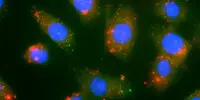Cancer resists therapy in a variety of ways, but a new algorithm has been devised that can decode all of them simultaneously. In a new study published in Cancer Discovery, scientists at the University Of California San Diego School Of Medicine used a machine learning algorithm to tackle one of the most difficult tasks for cancer researchers: predicting when cancer would reject chemotherapy.
All cells, including cancer cells, use intricate molecular machinery to reproduce DNA during normal cell division. Most chemotherapies function by inhibiting the DNA replication machinery in rapidly dividing tumor cells. While scientists realize that a tumor’s genetic composition has a significant impact on its specific therapeutic response, the huge number of mutations detected within tumors has made predicting drug resistance difficult.
The new method overcomes this hurdle by investigating how many genetic alterations affect a tumor’s response to medications that inhibit DNA replication. They specifically tested their model on cervical cancer tumors and were successful in projecting responses to cisplatin, one of the most commonly used chemotherapy medications. The model was able to identify cancers with the highest probability of treatment resistance, as well as much of the underlying molecular machinery that drives treatment resistance.
Cancer is a network-based disease driven by many interconnected components, but previous machine-learning models for predicting treatment resistance don’t always reflect this. Rather than focusing on a single gene or protein, our model evaluates the broader biochemical networks vital for cancer survival.
Trey Ideker
“Clinicians were previously aware of a few individual mutations that are associated with treatment resistance, but these isolated mutations tended to lack significant predictive value. The reason is that a much larger number of mutations can shape a tumor’s treatment response than previously appreciated,” Trey Ideker, PhD, professor in the Department of Medicine at UC San Diego Medicine, explained. “Artificial intelligence bridges that gap in our understanding, enabling us to analyze a complex array of thousands of mutations at once.”
One of the challenges in understanding how tumors respond to drugs is the inherent complexity of DNA replication — a mechanism targeted by numerous cancer drugs.
“Hundreds of proteins work together in complex arrangements to replicate DNA,” Ideker noted. “Mutations in any one part of this system can change how the entire tumor responds to chemotherapy.”

The researchers concentrated on the standard set of 718 genes typically used in clinical genetic testing for cancer classification, and used mutations within these genes as the starting point for their machine-learning model. After training using publicly available medication response data, the model identified 41 molecular assemblies (groups of collaborating proteins) where genetic changes affect therapeutic efficacy.
“Cancer is a network-based disease driven by many interconnected components, but previous machine learning models for predicting treatment resistance don’t always reflect this,” Ideker stated in a press release. “Rather than focusing on a single gene or protein, our model evaluates the broader biochemical networks vital for cancer survival.”
After training their model, the researchers put it to the test in cervical cancer, in which roughly 35% of tumors persist after treatment. The model was able to accurately identify tumors that were susceptible to therapy, which were associated with improved patient outcomes. The model also effectively pinpointed tumors likely to resist treatment.
In addition to anticipating treatment responses, the model offered light on its decision-making process by identifying the protein assemblies that drive treatment resistance in cervical cancer. The researchers underline that this component of the model—the ability to interpret its reasoning—is critical to the model’s success as well as the development of trustworthy AI systems.
“Unraveling an AI model’s decision-making process is crucial, sometimes as important as the prediction itself,” Ideker said in a statement. “Our model’s transparency is one of its assets, first because it instills trust in the model, and second because each of the molecular assemblies we’ve uncovered could be a new target for chemotherapy. We believe that our model will have widespread uses, not just in improving existing cancer treatments but also in pioneering new ones.”
















